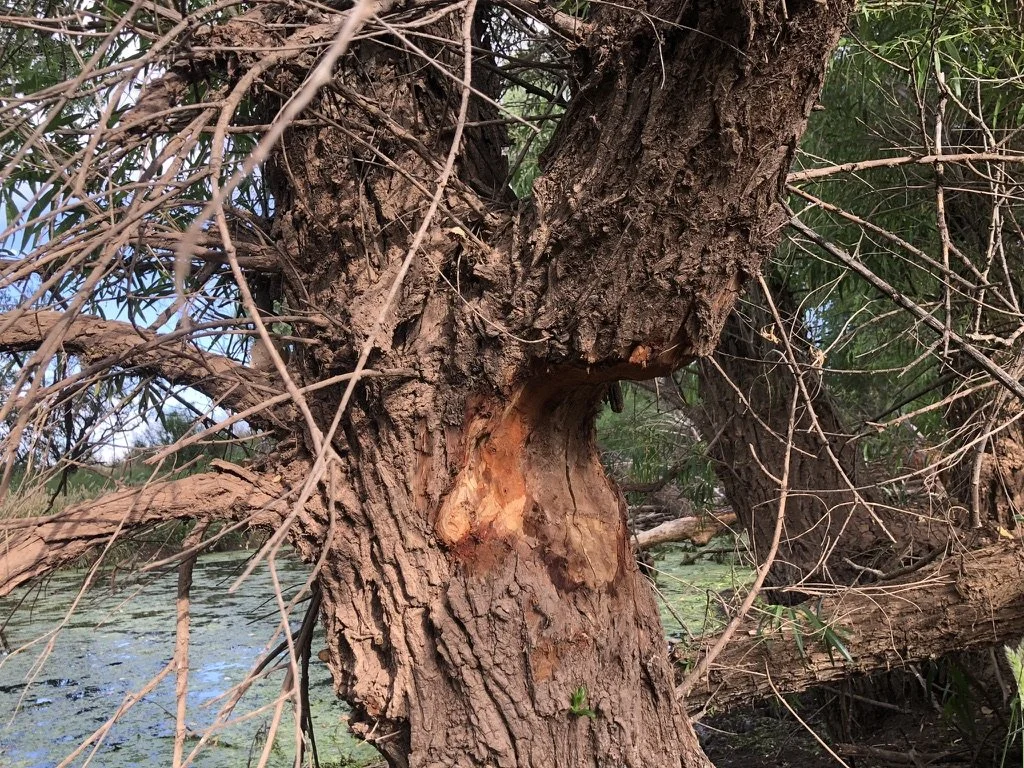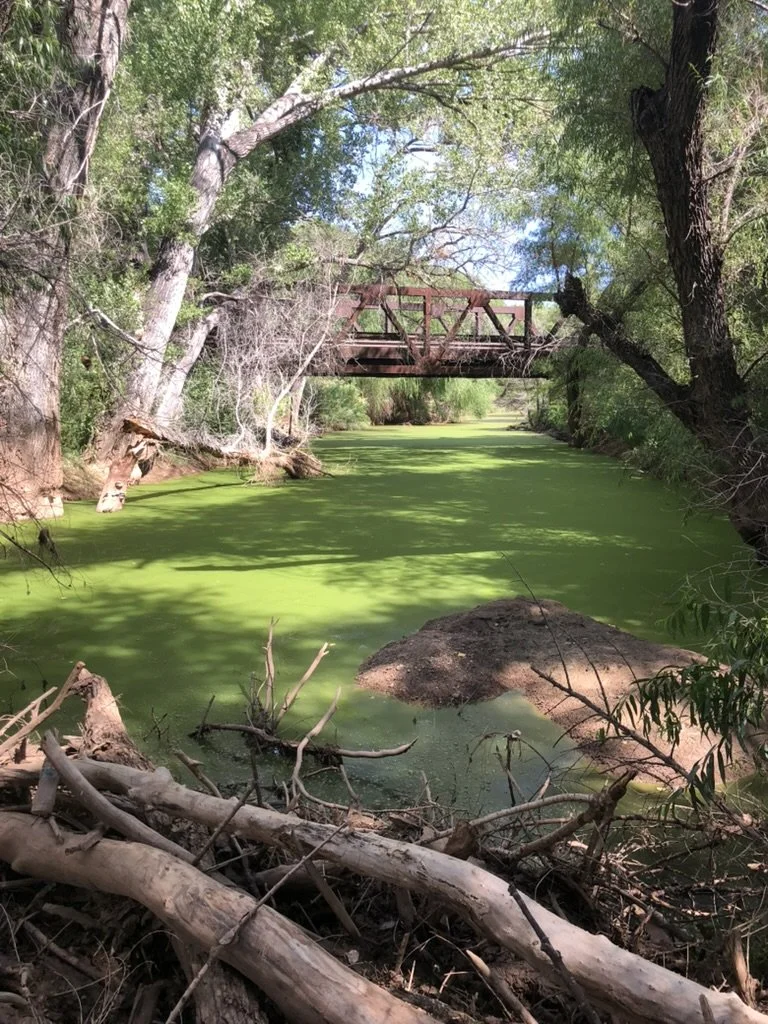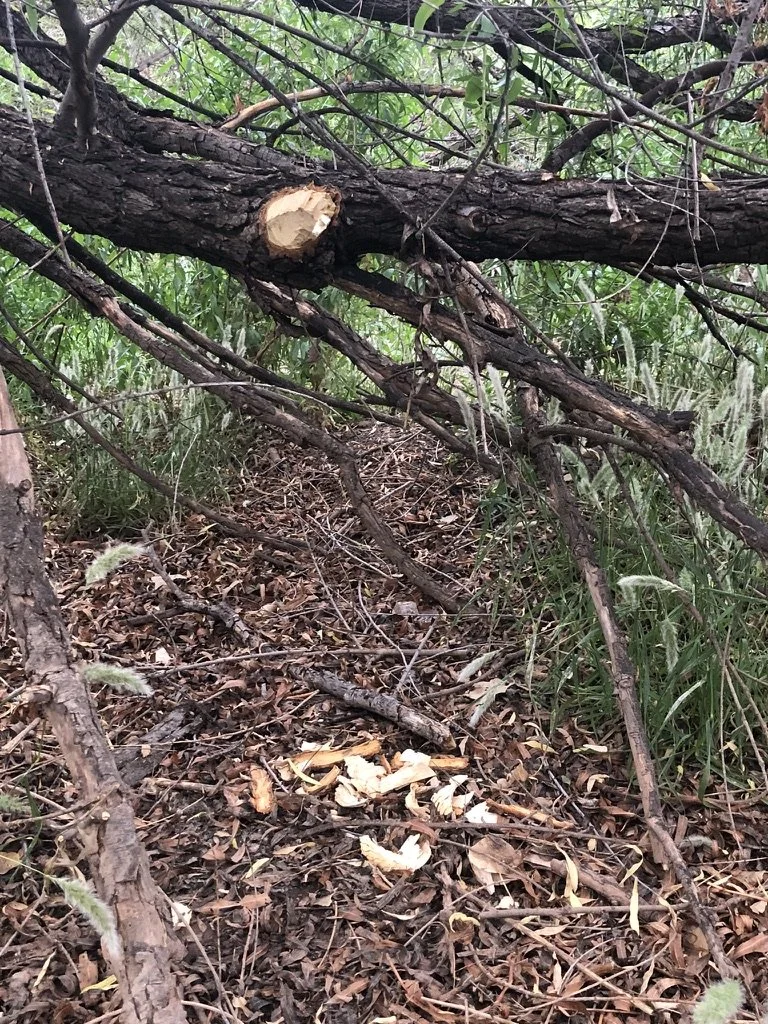A RIVER WITH TEETH
by Bea Troxel
It’s the summer of 2025 and I’m studying the beaver. I’m one year into living in the semiarid desert, a newcomer to Tucson, pushing my hands through brittle willow, looking out for rattlesnakes with each step, slipping on mud, hands landing on chewed logs. I am searching for beavers in southern Arizona. They used to run wild in the San Pedro river, a river that runs from central Arizona into Mexico. James Ohio Patty, a famed trapper in the Southwest, once called it the Beaver River back in the 1800s because of how many beavers swam and slapped the waters. But today, when I mention beavers, people wonder why on earth I could be looking for them in Arizona. Dry and dusty as it is, how could a beaver ever take up residence along these rivers?
Imagine spotting a tiny head in water, beady black eyes. Imagine spotting the glinting eyes and gasping. And as soon as you gasp a sound like a gunshot barrels at you from the water. Shakes your system, makes you jump and the beaver vanishes. This is a tail slap, the beaver’s alarm signal. And then imagine waiting, hoping that you can see those eyes again.
I’ve been searching for beavers for three years now, ever since I first spotted the tiny head in a pond in a park in Nashville. And now, in Tucson, I’m searching for the beaver in the borderlands, partaking in a summer fellowship through the Southwest Field Studies program at the University of Arizona. I know they’re here; studies have shown me; but I want to see them myself. Why? I just know that the beavers bring me to new places. I’ve learned to follow this obsession without understanding at first. I’m learning to trust the absence.
—
In September of 2024, just one month into living in Tucson, I attended a beaver fundraiser run by a local water conservation nonprofit. They were raising money to reintroduce a few beavers to the Santa Cruz river that runs through Tucson. The hope was that the beavers might repair and restore the watershed, might stop up some of the flowing river and push the water out into the banks, making it a flatter river. They encouraged the attendees to bike for sustainability reasons, so at dusk I hopped on my green Trek and pedaled past a high school and barking dogs and down a short, busy road. I wheeled into the backyard and locked up next to rows and rows of dusty bikes. A food truck sat at the edge of the yard. I walked through the awning and past a booth with two volunteers. One said, “Hello! Do you want to learn some facts about beavers?” I looked at him and grinned, “Sure!” I walked up but figured I probably knew most of his facts. And I did, everything he told me: beavers dramatically change a river system, often for the better, and folks are using them in river restoration, and that they welcome swans, muskrats, herons, fish wherever they live. But I’d been a know-it-all long enough and was practicing humility. I took a cute beaver sticker with me.
Next, at the dam building room for kids I ran into two acquaintances hilariously dressed as beavers. I didn’t know they were both interns at this nonprofit and didn’t expect to run into them. My shoulders relaxed. My face loosened. I was meeting a friend, and she showed up right after I ran into these beaver clad pals. Her blonde, wavy hair bounced down her linen dress. We walked into the dam building room and watched a video of beavers weaving sticks together. We cackled at their long, watery feet. After a few minutes she turned to me, put her hand on my shoulder and said, “Isn’t it wild that you moved to the desert and that there are beavers? It feels fated.” It did. I hadn’t even thought of this, the amount of faith I had in Something Bigger by moving across the country to pursue a degree in creative writing, not thinking about whether there would be beavers, leaving my home in Nashville and the beaver pond I visited every week.
—
The desert sun lessened in the few months after the fundraiser. Although I couldn’t see leaves changing as I could back in Nashville, the temperatures eased. I walked in the afternoon without fearing heatstroke. And in this cooler weather, the same water conservation organization would hold their fourth biannual beaver survey in November.
Like the volunteer told me at the fundraiser, beavers drastically change their landscapes. They eat bark and sticks and grass. They chew through the bases of trees to use the bark for food and the branches for dams and lodges. They weave sticks and mud together to block the flow of water. In Louisiana, they found dollar bills woven into the dam. All of this, so that they can swim further. Their safest spot is in water, and so they try to make their home stretch as far as possible, flooding banks and yards and houses with their dams. This flooding spreads water horizontally into the soil. So, say a fire rages through the area, the beaver flooded pond might ease the harm of those flames, keeping the ground wet. However, on the chance that a beaver floods someone’s backyard, that a beaver chews down a beloved tree, that someone may not take it as kindly as an ecologist might.
The San Pedro river has dug deeper and deeper into the ground over the past seventy years. Channelized, is the term scientists use. Or, a river with teeth, as a local naturalist tells me. This channelization means that when a monsoon pours rain, the river charges fast and swift through the river bed biting deeper and deeper into the earth. This is the opposite of how a beaver might affect a river. A beaver might slow that flow down so that the floods don’t sweep dirt and sand and rocks downriver with each rain. Back in the late 1990s, when the Bureau of Land Management started to reintroduce beavers back into the San Pedro, they hoped that beavers might slow down the waters and push the waters into the bank by building their dams. At the height of their return, in the 2010s, the beavers numbered around one hundred, but in the past fifteen years they’ve dwindled. The reasons could be mountain lions, flooding, less food along the banks. The exact reason is hard to pin down. The beaver survey sought to keep track of how many beavers still lived in the area.
On the morning of the beaver survey, my partner at the time and I laced up our boots, tucked our pants into our wool socks and packed peanut butter and jelly sandwiches. I burned the bread to black crisps. I journaled in the car as we drove south. Scrubby trees dotted the hillsides and the sunlight cast a gauzy pink over the landscape. The dust kicked up under the wheels. As we drove closer to the meeting spot near the river, a line of green began to form in the distance. Trees, shrubs, and vegetation clustered along what must have been the San Pedro river. It feels silly that it has taken me more than thirty years to notice that rivers form little oases around them. When I see lines of green, I notice the stark contrast to the desert brown and understand what is there.
Becoming a detective—like this noticing of green lines across the desert—was one reason the beavers first stole my heart. Whenever I went on walks in college with my friend Allie, she’d always stop, spot a branch or a nest in a tree and then think about the cause. She was born a detective, but her brain works so fast she doesn’t even need to sleuth. She connects the dots immediately. It has taken me years to see what is in front of me. But the beavers’ effect on their landscape in Tennessee (and anywhere!) was so broad and so obvious and immense that I couldn’t help but make sense of things. A felled tree, scraps of beaver chews scattered.
My partner and I pulled up to the parking lot and stood in an awkward circle with six other people. We said our names and jobs: a high school teacher, a wandering artist, a scientist, an undergrad animal science major, a sound engineer, a creative writer. Our leader instructed us to look for beaver slides (holes in the bank through which they would slide into the water), beaver chews (parts of trees where the beaver has chewed off the bark), lodges (homes), or dams (you know this!). We were to photograph anything we saw and upload it to the naturalist app. We packed into the vehicles that could handle the pot-holed, rocky roads, and drove to our designated section of the river.
Bright, golden cottonwood leaves fluttered in the breeze. It was autumn, and my heart paused at the sight of the yellow, reminding me of the seasons in Nashville, the lack of seasons here. Without paths, we pushed through the high grasses along the bank, often running into thorny vines and trees. All morning we saw nothing. I thought about how this river might be a perfect listening point, as the beaver pond in Nashville was for me. I wondered if I might drive down here once a month and wander the river for a few hours. If this could become my checking-in place.
We stopped under a giant cottonwood and ate our burned sandwiches silently with the pooled river in front of us. Once we kept walking, my partner yelled, “Bea! Here!” and I ran over to him to find a dark brown stump with old chew marks. Yes! He had identified an old beaver stump. A few minutes later someone else found a few other beaver gnawed branches and a hole in the dirt that ended in the creek bed. An old beaver slide. The wood had faded over time. Everything we found was old, no fresh traces of the beaver.
Beavers are both obvious and sneaky. They’re overt when they live in an area: felled trees and flooded waters. But finding them takes time and time and time because they could live anywhere along a river system! So my only expectations for this survey were to walk along a river and look. Searching sometimes works, but oftentimes just showing up allows for what we’re looking for to appear. Since this was my first time visiting the San Pedro River, I did not expect to see the beavers, let alone, fresh signs.
Other groups surveyed further portions of the river, also finding older remnants of beavers and one current dam, and the nonprofit released the survey in the late Spring of 2025. I discovered in an instagram post by the organization that they found one beaver dam along the river. They predicted up to eight beavers might be swimming around that area. I looked at the results on the website and tried to narrow it down on a map. Eight beavers! I was thrilled—I might be able to find some.
—
In preparation for the summer project studying the beavers, I read about the historical management of beavers in southern Arizona. I kept wanting to figure out how the beavers were killed by humans. But the more I researched, the more complicated it seemed. A large extinction of beavers occurred after a great flood in 1890, but before this flood, trappers had been catching beavers and selling their fur for many years. There are many reasons for their decline.
The San Pedro River and how it has cut deeper into the bank, how the banks have widened, how the influx of people in the 1960s have affected the amount of water over the years is what people in the area tell me about. The naturalists I meet tell me that the river floods the channel so that beavers cannot build homes along the banks. But then others tell me that beavers could build homes in the bank, so the beavers could live there if the predators didn’t wipe them out. And the predators wouldn’t wipe them out if the beavers didn’t have to waddle further from the bank for food. And yet, even as I write these reasons, I’m still guessing. I keep wanting to pick a side! It’s the rancher! The mountain lion! The settler! The climate!
—
Blame. Or, a reason. I’m often searching for the reason for things, often searching for a source. An early writing mentor told me over the phone, “Bea, I want to know why you want to defend the beavers so badly!” In my essays, I want to demonize the people who kill and trap beavers for their own benefit: to end flooding in their yards, to save their trees, to sell the fur. In my essays, I want to sing of their benevolent and mysterious nature. They chew and chew and chew and work and play and nest. But as I write this, if my home was flooded by water or I lost trees that I loved, I might risk killing a beaver to save my tree my home my forest. As if they were mine.
But, this blame, or need for reasons extends far past the beaver itself, who I am always defending. Why do we keep using the beavers as solutions to big issues in our rivers? Why do I need to find out what exactly caused the decline of beavers in the San Pedro? And what does learning about the state of San Pedro mean about humans living in the desert? I’m interested in the researchers Hastings and Turner, who wrote a book about the San Pedro and how it changed over the course of sixty years and then one hundred years. They continue to move between the idea that Anglo-Americans deeply affected the Sonoran desert after the 1880s and that their settlement and cattle use cannot be clearly cited as the only reason for the disruption to the San Pedro. They wrote this book in the 1960s, pioneering the term “climate change” long before it was a household term.
—
Later in the summer, my classmates and I travel down to southern Arizona, to the Hereford bridge, where the beaver survey map locates the remaining beaver. I walk over the bridge and try to determine how to get to the river underneath. The bridge is tall; the banks are thick with spikey brush, but soon we find a path that leads us to the water. We push through brush, get thwacked with the spiky thorns of Mesquite and Ironwood. Everything feels sharp in the Sonoran desert. I lean down over a tree that has a puddle of pencil-like shavings at the base and the pale belly of the trunk is exposed to the hot, dry air.
“Ahhh!!” I scream delightedly. “Beaver!” My classmates catch up to me. I hear them scratching their way through the brush until they get close to me. I point to the paleness. “These shavings are quite fresh.”
One of them remarks that I seem so alive.
I am alive, alive at the searching, alive at the finding. Alive at getting scratched at getting to push through the branches of trees to try and find some clue to the beavers. But also alive at the way that looking for this one animal has pushed me further and outwards. How examining the beaver’s impact and history in the San Pedro hints to many other histories: the colonization of the area by Anglo Americans, the flooding of the river in the 1890s and 1990s, the pervasiveness of cattle and their devastating impact on the soil and grasslands, the changing life of the river. The way that looking deeply at a place makes everything more complex, more nuanced.
—
Two months later, I return to the Hereford bridge on my own. I’m determined to find more signs of these beavers. I spend two hours pushing my body through the willow on the bank, slipping, walking across the river over blocked logs. Finally, after walking and walking and finding no signs of the beaver I pause and eat my sandwich on the bank. Sweat pours down my face. I’m smiling, giddy with the presence of searching. How looking for the beavers keeps me honed completely in the present moment. How looking for the beavers returns me to self again and again. How looking for the beavers is sometimes fruitless. The acceptance of this.
As I’m driving away I see a man on the road carrying a camera and a tripod. He appears to visit here often, so I pull my car up next to him and ask, “Hi! Do you come here a lot?” He said, “Oh, all the time!” And I ask, “Have the beavers been active?” “Yes! Someone saw one swimming the other day just under the bridge.”
Aha! So they’re not way up the river; they’re right under the bridge; right under my own little nose. The next morning I wake up early and drive out to the bridge. I walk under the it, perch myself in the mud and sit. I sit for a long time. I watch a frog try to leap onto a branch and hit it and fall back in the water. I watch bugs crawl around on the ground. And I look at the mud and see the footprints of maybe…maybe…a beaver. Maybe they’re here.


